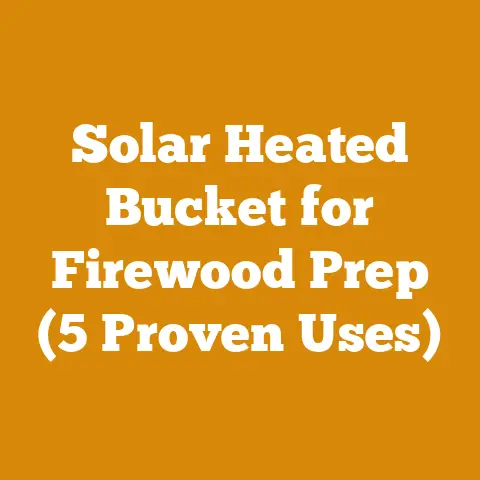How to Clean Off Creosote (5 Proven Chimney Safety Hacks)
“The best time to plant a tree was 20 years ago. The second best time is now.” – Chinese Proverb.
As someone who has spent countless hours around wood stoves and fireplaces, I can tell you firsthand that creosote is not something to take lightly. It’s a silent threat that builds up in your chimney, turning cozy fires into potential hazards. Over the years, I’ve learned a thing or two about keeping chimneys clean and safe. Let me walk you through some proven chimney safety hacks to tackle creosote buildup effectively.
Understanding Creosote: The Silent Chimney Threat
Creosote is a byproduct of burning wood, formed when smoke condenses in your chimney. It’s a dark, oily, and highly flammable substance that clings to the inner walls. Think of it as the cholesterol of your chimney – too much, and you’re headed for trouble.
What Exactly is Creosote?
Creosote is essentially unburned wood particles mixed with gases that condense as they cool in the chimney. This condensation happens because the chimney is cooler than the smoke. The cooler the chimney, the more creosote you get.
The Different Stages of Creosote
Creosote comes in three stages, each more dangerous than the last:
- Stage 1: This is a light, flaky soot that’s relatively easy to remove. It’s usually the result of burning seasoned wood at a good temperature.
- Stage 2: This is a more tar-like substance, often shiny and hard to remove. It’s usually caused by burning unseasoned wood or low-temperature fires.
- Stage 3: This is the most dangerous – a hard, glazed coating that’s extremely difficult to remove and poses a significant fire risk. This is usually the result of long-term neglect and smoldering fires.
Why Creosote is Dangerous
Creosote is highly flammable. Even a thin layer can ignite, leading to a chimney fire. These fires can be extremely dangerous, spreading to your home and causing significant damage. According to the National Fire Protection Association (NFPA), chimney fires are a leading cause of residential fires, with thousands occurring each year.
Takeaway: Understanding creosote is the first step in preventing chimney fires. Knowing the different stages and the dangers they pose will help you take the necessary precautions.
Hack #1: Burn Seasoned Wood
Burning seasoned wood is the cornerstone of chimney safety. It’s not just about getting a better fire; it’s about preventing creosote buildup. I can’t stress this enough.
The Importance of Seasoned Wood
Seasoned wood has a moisture content of 20% or less. This means it burns hotter and cleaner, producing less smoke and creosote. Unseasoned wood, on the other hand, can have a moisture content of 50% or more. This wet wood smolders, creating excessive smoke and accelerating creosote buildup.
How to Season Wood Properly
Seasoning wood takes time and patience, but it’s well worth the effort. Here’s how I do it:
- Split the Wood: Splitting wood increases the surface area, allowing it to dry faster.
- Stack It Properly: Stack the wood in a single row, elevated off the ground, with plenty of space between rows for air circulation.
- Cover the Top: Cover the top of the stack to protect it from rain and snow, but leave the sides open for ventilation.
- Be Patient: Allow the wood to season for at least six months, or ideally a year.
Identifying Seasoned Wood
How do you know if your wood is properly seasoned? Here are a few signs:
- Cracks: Seasoned wood will have cracks on the ends.
- Weight: It will feel significantly lighter than unseasoned wood.
- Sound: When you knock two pieces together, they should sound hollow.
- Moisture Meter: A moisture meter is the most accurate way to check. Aim for a reading of 20% or less.
I use a moisture meter religiously. It’s a small investment that pays off big time in terms of safety and efficiency. I prefer using a Delmhorst BD-2100, but there are many good options available.
Take the time to season your wood properly, and you’ll significantly reduce creosote buildup.
Hack #2: Burn Hotter, Cleaner Fires
The way you burn your fire can significantly impact creosote buildup. Hotter, cleaner fires produce less smoke and creosote. I’ve seen firsthand how a simple change in burning habits can make a huge difference.
The Benefits of Hot Fires
Hot fires burn more completely, reducing the amount of unburned wood particles that end up as creosote. They also help to keep the chimney warmer, reducing condensation.
How to Build a Hotter Fire
Here are some tips for building a hotter fire:
- Use Kindling: Start with plenty of dry kindling to get the fire going quickly.
- Top-Down Burning: Try the top-down burning method, where you place larger logs at the bottom and kindling on top. This allows the fire to burn downwards, creating a hotter, cleaner burn.
- Airflow: Ensure proper airflow to the fire. Open the air vents on your stove or fireplace to allow plenty of oxygen to reach the flames.
Avoiding Smoldering Fires
Smoldering fires are creosote factories. They produce a lot of smoke and very little heat. Avoid them at all costs. Never damp down the fire too much, and always ensure there’s enough airflow to keep the flames burning brightly.
I remember one winter when I was trying to conserve wood by dampening the fire too much. My chimney quickly became coated with creosote, and I had to call a professional to clean it. Lesson learned!
Takeaway: Burning hotter, cleaner fires is crucial for reducing creosote buildup. Pay attention to your fire-building techniques and avoid smoldering fires.
Hack #3: Regular Chimney Inspections
Regular chimney inspections are non-negotiable. They’re like regular check-ups for your car – they can catch small problems before they become big ones.
Why Inspections are Important
A professional chimney sweep can identify potential problems, such as cracks, blockages, and excessive creosote buildup. They can also assess the overall condition of your chimney and recommend any necessary repairs.
How Often to Inspect
The NFPA recommends that chimneys be inspected at least once a year, even if you don’t use your fireplace frequently. If you burn wood regularly, you may need to inspect your chimney more often.
What to Expect During an Inspection
During a chimney inspection, the sweep will typically:
- Inspect the exterior of the chimney for cracks, damage, and proper height.
- Inspect the interior of the chimney for creosote buildup, blockages, and damage.
- Check the condition of the flue liner.
- Inspect the firebox and damper.
Finding a Qualified Chimney Sweep
Look for a chimney sweep who is certified by the Chimney Safety Institute of America (CSIA) or the National Chimney Sweep Guild (NCSG). These organizations provide training and certification to ensure that sweeps are qualified to perform inspections and cleanings.
I’ve used several chimney sweeps over the years, and I always ask for references and check their credentials before hiring them. It’s worth the extra effort to find someone who knows what they’re doing.
Takeaway: Regular chimney inspections are essential for identifying and addressing potential problems. Hire a qualified chimney sweep to inspect your chimney at least once a year.
Hack #4: DIY Chimney Cleaning
While professional chimney cleaning is recommended, you can also perform some basic cleaning yourself to help maintain your chimney between professional visits.
When to DIY Clean
DIY cleaning is best suited for removing light creosote buildup (Stage 1). If you have Stage 2 or 3 creosote, it’s best to leave it to the professionals.
Tools You’ll Need
Here are the tools I use for DIY chimney cleaning:
- Chimney Brush: Choose a brush that’s the correct size and shape for your chimney flue. I use a poly brush for stainless steel liners and a wire brush for masonry chimneys.
- Extension Rods: You’ll need extension rods to reach the top of your chimney.
- Drop Cloths: Cover your fireplace and surrounding area with drop cloths to protect them from soot.
- Dust Mask and Goggles: Protect yourself from inhaling soot and dust.
- Shop Vacuum: Use a shop vacuum to clean up the soot.
Step-by-Step Cleaning Guide
- Prepare the Area: Remove any furniture from the area around your fireplace and cover everything with drop cloths.
- Seal the Fireplace: Seal the fireplace opening with plastic sheeting and duct tape to prevent soot from escaping into your home. Cut a small hole in the plastic to insert the chimney brush.
- Clean the Chimney: Insert the chimney brush into the flue and push it up and down, using the extension rods to reach the top of the chimney. Be thorough and make sure you scrub the entire surface of the flue.
- Remove the Brush: Carefully remove the brush and rods from the chimney.
- Clean the Firebox: Use a brush and scraper to clean the firebox, removing any soot and ash.
- Vacuum the Soot: Use a shop vacuum to clean up the soot from the fireplace and surrounding area.
- Dispose of the Soot: Dispose of the soot properly. I usually double-bag it and throw it away with the regular trash.
Safety Precautions
- Always wear a dust mask and goggles to protect yourself from inhaling soot and dust.
- Be careful when working on the roof. Use a ladder and safety harness if necessary.
- If you’re not comfortable cleaning your chimney yourself, hire a professional.
Takeaway: DIY chimney cleaning can help maintain your chimney between professional visits. Use the right tools, follow the steps carefully, and always prioritize safety.
Hack #5: Chimney Cleaning Logs and Creosote Removers
Chimney cleaning logs and creosote removers are chemical treatments that can help to reduce creosote buildup. They’re not a substitute for regular cleaning, but they can be a useful supplement.
How They Work
Chimney cleaning logs contain chemicals that, when burned, release gases that help to break down creosote. Creosote removers are typically applied to the fire or directly to the chimney walls.
Types of Products
There are several types of chimney cleaning logs and creosote removers available, including:
- Chimney Cleaning Logs: These logs are burned in the fireplace to release chemicals that break down creosote.
- Creosote Remover Sprays: These sprays are applied directly to the chimney walls to dissolve creosote.
- Creosote Remover Powders: These powders are sprinkled on the fire to release chemicals that break down creosote.
How to Use Them
Follow the manufacturer’s instructions carefully when using chimney cleaning logs or creosote removers. Typically, you’ll burn the log in your fireplace according to the instructions on the package. For sprays and powders, follow the application instructions provided.
Effectiveness
While chimney cleaning logs and creosote removers can help to reduce creosote buildup, they’re not a substitute for regular professional cleaning. They’re most effective when used in conjunction with other preventative measures, such as burning seasoned wood and burning hotter fires.
I’ve used chimney cleaning logs in the past, and I’ve found them to be helpful in reducing light creosote buildup. However, I always make sure to have my chimney professionally cleaned at least once a year.
Safety Considerations
- Always follow the manufacturer’s instructions carefully.
- Never use more product than recommended.
- Store chimney cleaning logs and creosote removers out of reach of children and pets.
- Ensure adequate ventilation when using these products.
Takeaway: Chimney cleaning logs and creosote removers can be a useful supplement to regular chimney cleaning. Use them as directed and always prioritize safety.
Additional Tips for Chimney Safety
Beyond the five main hacks, here are some additional tips to keep your chimney safe:
Chimney Caps
Install a chimney cap to prevent rain, snow, leaves, and animals from entering your chimney. This can help to prevent blockages and corrosion.
Flue Liners
Ensure that your chimney has a properly installed flue liner. The flue liner protects the chimney walls from heat and corrosion and helps to prevent creosote from seeping into the masonry. If your flue liner is damaged, have it repaired or replaced immediately.
Carbon Monoxide Detectors
Install carbon monoxide detectors in your home, especially near sleeping areas. Carbon monoxide is a colorless, odorless gas that can be deadly. A properly functioning carbon monoxide detector can alert you to the presence of this gas, giving you time to evacuate your home.
Fire Extinguishers
Keep a fire extinguisher readily available near your fireplace. Make sure you know how to use it properly. A fire extinguisher can help you to put out a small fire before it spreads.
Regular Maintenance
Perform regular maintenance on your fireplace and chimney. This includes cleaning out the firebox, checking the damper, and inspecting the chimney for cracks and damage.
Emergency Preparedness
Have a plan in place in case of a chimney fire. Know how to evacuate your home safely and how to contact the fire department.
Case Studies and Real-World Examples
To illustrate the importance of chimney safety, let’s look at some real-world examples:
Case Study 1: The Neglected Chimney
A homeowner neglected to have their chimney inspected or cleaned for several years. As a result, a thick layer of Stage 3 creosote built up in the chimney. One cold winter night, the creosote ignited, causing a chimney fire that spread to the attic. The fire caused significant damage to the home, and the homeowner had to spend thousands of dollars on repairs.
Case Study 2: The Seasoned Wood Saver
A homeowner made a conscious effort to burn only seasoned wood and to burn hotter fires. They also had their chimney inspected and cleaned regularly. As a result, they experienced very little creosote buildup and never had any chimney fires.
Real-World Example: My Own Experience
I once had a close call with a chimney fire. I had been burning unseasoned wood and had neglected to have my chimney cleaned. One night, I noticed a strange smell and saw smoke coming from the top of my chimney. I immediately called the fire department, who arrived quickly and extinguished the fire before it could spread to my home. I learned a valuable lesson that day, and I’ve been diligent about chimney safety ever since.
The Future of Chimney Safety
As technology advances, there are new tools and techniques emerging to improve chimney safety. These include:
Advanced Chimney Inspection Technology
New technologies, such as video cameras and thermal imaging, are being used to inspect chimneys more thoroughly and accurately. These technologies can help to identify hidden problems that might otherwise be missed.
Improved Creosote Removal Methods
Researchers are developing new and more effective methods for removing creosote from chimneys. These methods include chemical treatments and mechanical cleaning techniques.
Smart Fireplaces and Stoves
Smart fireplaces and stoves are equipped with sensors and controls that can help to optimize burning conditions and reduce creosote buildup. These devices can also alert you to potential problems, such as excessive smoke or carbon monoxide.
Conclusion: Prioritizing Chimney Safety
Chimney safety is not something to take lightly. By following these proven chimney safety hacks, you can significantly reduce the risk of chimney fires and keep your home and family safe. Remember to burn seasoned wood, burn hotter fires, have your chimney inspected regularly, perform DIY cleaning when appropriate, and use chimney cleaning logs and creosote removers as directed. Stay vigilant, stay informed, and stay safe.






